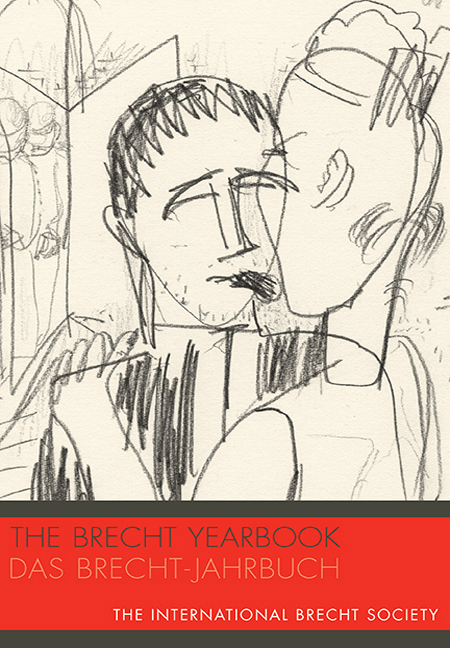Book contents
- Frontmatter
- Contents
- Editorial
- Tribute
- Documents from the Inaugural 24h DURCHEINANDER in Berlin
- Brecht-Images: Artist’s Introduction
- New Brecht Research
- The Temporality of Critique: Bertolt Brecht's Fragment Jae Fleischhacker in Chikago (1924–1929)
- Apparate und Körper: Überlegungen zu Bertolt Brechts Radiolehrstück Der Ozeanflug
- Wer ist Oscar? Ein unveröffentlichter Brief an Brecht vom 12. Juni 1918 aus schottischer Kriegsgefangenschaft
- “leg das buch nicht nieder, der du das liesest, mensch”: Brechts Gedicht “Die Nachtlager”
- Übersehen oder verbannt? Hanns Eislers Bilder aus der Kriegsfibel
- Special Insert: Accompaniments to Brecht, Music, and Culture
- Das “Wiedersehen”: Der chinesische Dichter und Germanist Feng Zhi und Bertolt Brecht
- Brechtian Challenges to Theater Artists during the Internal War in Peru
- “Good Woman should have been done in one of our big theaters long before this”: Brecht, the Students, and the Making of the New Wave of Australian Theater
- Mark Twain's “Magnanimous-Incident” Hero and Bertolt Brecht's Der gute Mensch von Sezuan
- Navid Kermani's Literary Reflections: On Kafka, Brecht, and the Koran
- Karl Kraus und Bertolt Brecht: Über die Vergleichbarkeit des Unvergleichlichen
- Book Reviews
- Notes on the Contributors
Brechtian Challenges to Theater Artists during the Internal War in Peru
from New Brecht Research
Published online by Cambridge University Press: 11 March 2017
- Frontmatter
- Contents
- Editorial
- Tribute
- Documents from the Inaugural 24h DURCHEINANDER in Berlin
- Brecht-Images: Artist’s Introduction
- New Brecht Research
- The Temporality of Critique: Bertolt Brecht's Fragment Jae Fleischhacker in Chikago (1924–1929)
- Apparate und Körper: Überlegungen zu Bertolt Brechts Radiolehrstück Der Ozeanflug
- Wer ist Oscar? Ein unveröffentlichter Brief an Brecht vom 12. Juni 1918 aus schottischer Kriegsgefangenschaft
- “leg das buch nicht nieder, der du das liesest, mensch”: Brechts Gedicht “Die Nachtlager”
- Übersehen oder verbannt? Hanns Eislers Bilder aus der Kriegsfibel
- Special Insert: Accompaniments to Brecht, Music, and Culture
- Das “Wiedersehen”: Der chinesische Dichter und Germanist Feng Zhi und Bertolt Brecht
- Brechtian Challenges to Theater Artists during the Internal War in Peru
- “Good Woman should have been done in one of our big theaters long before this”: Brecht, the Students, and the Making of the New Wave of Australian Theater
- Mark Twain's “Magnanimous-Incident” Hero and Bertolt Brecht's Der gute Mensch von Sezuan
- Navid Kermani's Literary Reflections: On Kafka, Brecht, and the Koran
- Karl Kraus und Bertolt Brecht: Über die Vergleichbarkeit des Unvergleichlichen
- Book Reviews
- Notes on the Contributors
Summary
The experience of the internal war in Peru (1980–2000), in which the Shining Path Communist guerrilla and a repressive state faced each other, meant a tremendous challenge to Peruvian theater artists. Located as it was between these two aggressors, the cultural sphere had to find unique ways to tackle issues of conflict and violence without exposing its participants to reprisal. Between two fires, cultural figures had to discover how to face those fires without getting burned. Interestingly, several Peruvian theatrical figures of the era, particularly from the independent theater, focused on the works and ideas of Brecht as a resource for addressing the social injustice of the armed conflict. They did so without being charged or violently attacked by the opposite side. Peruvian theater artists exhibited a persistent concern for discussing the roots of the evil in social violence while rethinking theoretical and aesthetic paradigms taken from Bertolt Brecht's writings.
Before discussing how important Brechtian aesthetics were for politically engaged theater, it is necessary to highlight how the presentation of violence circulated in the Peruvian theater during the internal war. Unlike many other cultural forms, the social nature of performance evinced the intentions of individual producers—often with great risk. Theater exposes civilian participants to greater risks, given the public consumption and transmission of its messages. Unlike the literary field, which did not require a personal confrontation, Peruvian theater during the internal war circulated artistic messages that addressed the violence, intervening in political life and thus exposing the participants (artists and audiences) to the danger of the war.
Such extreme political violence can help us to understand the unique context in which Peruvian theater artists developed their work during these decades. It can also help to comprehend why certain rhetorical devices in plays (such as fables of foreign places, symbolism, and anti-verbal theater forms, and encryption of messages in complex, surrealist speeches), appeared as appropriate strategies to be implemented in scenes that conveyed highly charged political intentions.
All of the works reviewed here were produced by dramatists and writers involved in what is called independent theater production in Peru, and can be seen as expressions of the concerns Peruvian artists experienced regarding their future after the period of violence.
- Type
- Chapter
- Information
- The Brecht Yearbook / Das Brecht-Jahrbuch 40 , pp. 156 - 169Publisher: Boydell & BrewerPrint publication year: 2016



